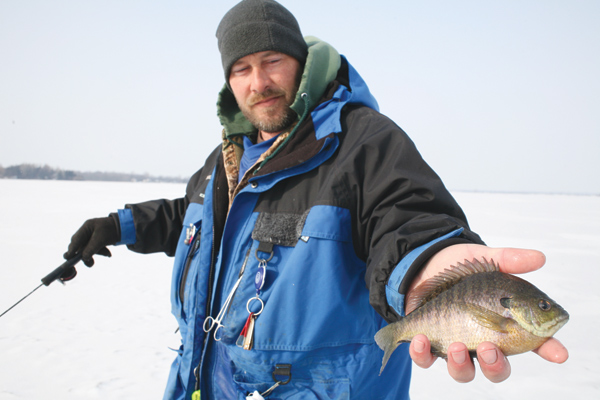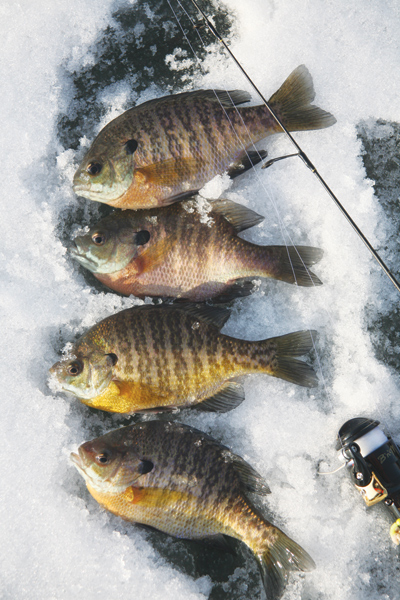 Fish & Tackle: Bluegills Under Ice
Fish & Tackle: Bluegills Under Ice
By Fish & Tackle Editor Vic Attardo

The snow devil whirling across the ice gave a fair indication of how tough the fishing might be that day. Two in our party voted to go home, but then it was pointed out that a cove on the far shore was bordered by a high ridge that would block the stiff breeze. Also, it was discussed that if we set up on the south side of that cove, the sun would lessen the chill and, perhaps, improve our winter moods.
But while fishing near that sunny shore, what really improved attitudes was the surprising number of big bluegills we put on the ice. The ’gills had moved into the deep edge of a wide weedbed. The milfoil stems in this fertile, natural lake were sparse beyond the 10-foot depth but thickened as the lake shallowed from 8 feet to just under 5. Even though it was the middle of winter, the weeds were so thick at 5 feet we would have needed a submersible weed whacker to get a jig to fall to the bottom.
The bluegills began hitting about 30 minutes after sunrise, and the bite gradually heated up to the point that we were pulling up doubles, and then even a triple.
For some reason or other, one in our band decided that rather than fish, he would make his way around the lake talking to other ice anglers as he went. After his tour, he reported that some had picked up a few panfish here and there, but elsewhere throughout the kidney-shaped lake, the bite was slow to nonexistent.
We definitely were doing better than the norm, and we attributed it to the weed edge, sun on the ice, and a wind-blocking ridge. Yes, we, too, experience slow days on the ice. But when it comes to catching bluegills during the tough times of mid to late winter, we count on these three things, and a few other keys, to improve our chances.
Without debate, the middle of winter is a tough time to ice-fish. The snow pack is usually heavy, the ice equally dense, and the water down below dark and uniformly cold. In addition, the macro-invertebrates that bluegills feed on require sunlight to get active, and they are not getting what they need, either. Most hold in the mud rather than crawl around on the bottom. With this dreariness all about them, the bluegills can become slow to inactive.
Yet while we don’t expect a gangbuster day under such conditions, we know that in all probability, some bluegills will be eating at some time at some place in the lake. These are the fish we hope to catch, and the first place we look is in weed pockets or on the outer edge of a moderately deep weedline. Best depths vary based on the type and structure of the lake, but pockets and outer edges are the common element that can be relied on just about everywhere.
These bluegills may come into a weedline from a greater depth or move out from the dense jungle of weeds in shallower water. Regardless, they are looking for schools of tiny baitfish. The insects may not be active or even available, but tiny fish, either late-season fry of larger game fish or true minnow species, will be in roving schools, and feeding gills have a better chance of ambushing slow-moving schools along a weed edge or in a pocket. It’s almost always a good idea to locate weed edges and pockets and then repeatedly jig as many of these spots as possible.
We jokingly call it “hole hopping,” and it allows us to work a considerable amount of water.
With dozens of holes drilled and slushed out, we go from one to the next, dropping a jig tipped with soft plastic and larva bait. The idea is to catch the aggressive bluegills in these locations. After landing a fish or two, we move on to the next hole and the next and the next.
When hole-hopping, it’s wise to drill holes every 6 to 8 feet. This gives plenty of opportunity to work the active weed edges or pocket. It’s not unusual for a group of four or five hole-hoppers to rotate around 50 or more ice holes. It makes for a lot of hopping, and hopefully a lot of catching.
If an ice angler were to simply stay at the same hole after a catch, in these midwinter conditions, it might be a long time before the next bluegill came along. Staying put is fine when bluegills are more active in the early and late ice seasons. Then, you may wait for the fish to come to you. But in midwinter, it’s best to hunt and peck away at the fish.
The basic idea is to present a bait to the one or two bluegills beneath a hole, get them to react, and then move on. If you pull a bluegill from a good spot, in time, another will drift over and take its place. Then, when you return after making the rounds, you may catch this fresh fish. Think of it as running a winter trapline, only for panfish.
For a few years, anglers were shoveling snow from wide areas, making what looked like mini skating rinks and then fishing this open ice. Somebody, somewhere, must have gotten this bright idea, and then it spread like wildfire. The theory behind it does sound good: uncover ice to allow light to penetrate and get the insects moving, and, in turn, make the bluegills active. The problem is the fish have grown accustomed to the low light, and to suddenly see open ice in one area just isn’t natural. The premise doesn’t work.
However, it is important to play the sun correctly. If there are high banks or hills around the shoreline—often the case in hill country—it’s a good idea to avoid shady areas while still fishing along weedlines and in weed pockets. Use the sunshine, just don’t try to enhance the effect by removing snow from the ice.
Many anglers use moveable ice huts this time of year, and I find these both a plus and a minus. Surrounded by the dark covering, I can better peer into the water and see the bluegills. But the hut negates the ability to quickly hop from one divot to another. Huts are great for comfort, for getting out of the wind. But they don’t fit well with my preferred style of run-and-gun midwinter ice-fishing.
Later in the season, when bluegills are more on the move and I can remain somewhat stationary, a moveable ice hut comes in handy for sight-fishing in shallow water. The stationary ice houses that are established for an entire season and left in place are best situated over a very good piece of structure that may attract fish all season long.
Technically, January is a midwinter month everywhere in the United States. But in regions with a short ice season, mid to late January may be near the end of ice season, and this can present fresh opportunities.
When the pack snow melts, either from increased sunlight or rain, the water seeps into the edges of the lake. The initial influx is usually not good; but as it mixes with the lake water, the increased flow gets the bugs moving, which wakes up the gills. We usually wait three to five days after a rain and then try to get in on the action. In effect, conditions are similar to the melting ice at the end of the season, which sends water swirling into open holes and begins a new season of weed growth.
Another way we increase our chances of bluegill success in midwinter is to fish very small baits. Often, a bluegill will take a nip, and if it doesn’t get something it likes, there’s no hunger to take a second bite. I often see this while hole-hopping. I lower a bait, get an immediate bite, but if I don’t connect, there’s no second chance.
I usually move on to another hole but plan on coming back to the short-biting fish sometime later. To hook more of these short-biters, I may step down to a size 12 jig with the tiniest of micro soft-plastics on the hook. I want a bluegill to be able to take the lure with a single vacuum suck. A bluegill is likely to nip, nip, nip at a larger jig and hook without getting caught.
One other way to catch more of these bluegills is to anticipate the bite before it happens, so there is no delay in setting the hook. I do this by watching the fish approach on a Vexilar flasher screen. The fish typically slides up beside the bait and then strikes.
I might be feeling cold and disinterested—until out of the icy blue a green line approaches my jig, as seen on the dial. Before the line even twitches, I’m ready to set the hook. If you can react to that first tentative bite, rather than wait for the rod tip to dip and signal the take, you are going to hook and land a lot more midwinter bluegills.
The deeper into ice season we get, the harder it becomes to load the bucket with a good catch. But with the attention to detail that midwinter ice demands, you can still go home with enough gills to make the trip worthwhile, and a bluegill dinner is most delicious and satisfying when it has been earned this way.
